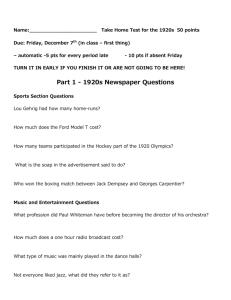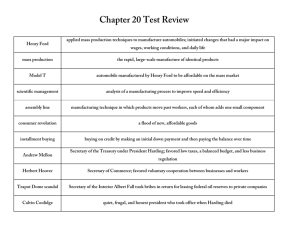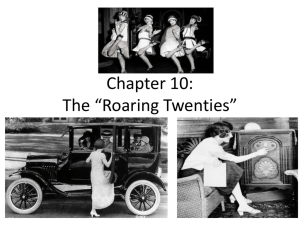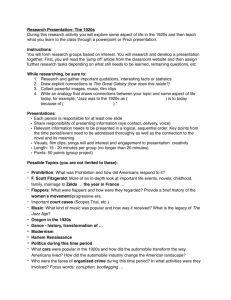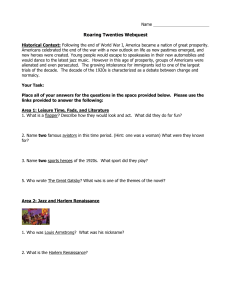File
advertisement
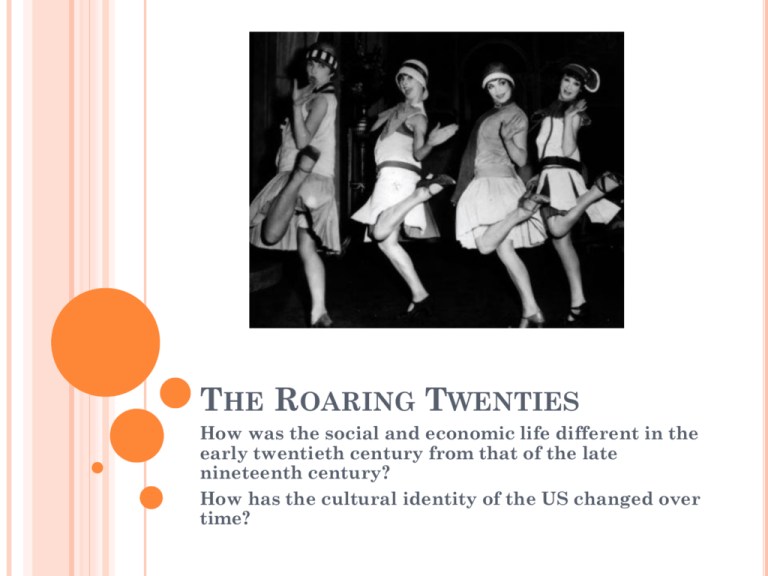
THE ROARING TWENTIES How was the social and economic life different in the early twentieth century from that of the late nineteenth century? How has the cultural identity of the US changed over time? “This is a story of America between two Wars, told in terms of the most significant, or typical, or utterly fantastic new events of the gaudy and chaotic years that separated Versailles from Pearl Harbor. . . We seem to have fluctuated between headaches: sometimes induced by prohibition, more frequently by the fevered pace of time. During these throbbing years we searched in vain for a cure-all, coming no closer to it than the aspirin bottle; hence: The Aspirin Age. . . Twenty-two prominent authors, all closely connected with the period have written . . . [what] is, I hope, no mere chronicling of the arresting events, but rather a recreation of a strange and almost somnambulistic time when America was much younger in spirit than it ever can be again.” -Isabel Leighton POLITICS OF THE 1920S LEQs: 1. How was Harding’s effort to return to “normalcy” prevented by political scandals? 2. What government policies helped the economy recover from the postwar recession? 3. Describe U.S. efforts to avoid future wars. A BETTER WORLD? Success 19th Amendment, trust busting, child labor laws BUT . . . Disillusionment Economic problems, labor unrest, racial tension, antiradicalism FAILURE OF PROGRESSIVISM “It is only once in a generation that a people can be lifted above material things. That is why conservative government is in the saddle twothirds of the time.” -Wilson Do better laws make better lives? WWI- US turns to isolationism Red Scare 16th Amend. fails to redistribute wealth Farmers, workers 19th Amend. few changes in politics 18th Amend. to save families openly disregarded 1920 ELECTION Issues over disillusionment, recession, peace treaty/LON fear of radicals, terrorists, l Labor unrest Workers, farmers Dem. James Cox vs. Rep. Warren G. Harding Last election campaign by phonograph 1921-1923: WARREN G. HARDING A return to normalcy HARDING “America’s present need is not heroics, but healing; not nostrums, but normalcy; not revolution, but restoration; not agitation, but adjustment; not surgery, but serenity; not the dramatic, but the dispassionate; not experiment, but equipoise; not submergence in internationality, but sustainment in triumphant nationality.” -WGH ON PROGRESSIVISM Americans “were tired of issues, sick at heart of ideals, and weary of being noble.” - William Allen White, progressive journalist PRESIDENTIAL FOCUS Return to normalcy Pre-Progressive Era Gov. out of business Opposition to social programs of Progressives Reject LON NOTABLE ISSUES Red Scare (1919-1921) Sacco-Vanzetti Trial Labor Unrest 4 strikes Immigration restriction Budget and Acct. Act (1921) Annual budget Dawes Plan (1924) Stabilize Weimar economy ($2.5 billion) England/France debt issue THE OHIO GANG: GRANT REDUX Harry M. Daugherty- Att.Gen. (crook) Albert Fall- SOI (prison) Andrew Mellon- SOT* Charles Evans Hughes- SOS* Herbert Hoover- SOC* Henry Wallace- AG Taft SC Justice TAXES AND TARIFFS Mellon Plan = effort to lower income taxes 60%50% 25%20% Wealth with few = capital investment 4% 3% Fordney-McCumber Tariff (1922) Chemical/metal products, farm goods Gov. spending cuts Nat’l debt lowered BALANCED BUDGET DISARMAMENT: 11/21-2/22 WGH- Desire to reduce army, isolate US from others 1921- Washington Naval Conference Hughes- SOS, in DC 4, 5, 9 Power Treaty DISARMAMENT Japan, GB, US Pacific Peace Cryptography Battleships lost 1928- Kellogg-Briand Pact NO USE OF WAR! SCANDAL! Teapot Dome (1923) = Watergate = corruption Others: Charles Forbes- Vet. Bur. Daughtery- Att.Gen. Prohibition bureau “I have no trouble with my enemies, I can take care of my enemies all right. But my damn friends. . . they’re the ones that keep me walking the floors at night!” - WGH “SILENT CAL” 1923-1928 A NEW OLD STYLE Image of traditional roots, solid integrity Revert to GA form: passive Pres., leadership in Congress He “aspired to become the least President the country had ever had. . .” THE BUSINESS OF AMERICA IS BUSINESS Focus on industrial development At expense of labor & AG Unleash free enterprise End gov. regulation Reduce taxes “Never before. . . Has a government been so completely fused with business.” -WSJ “After all, the chief business of the American people is business. They are profoundly concerned with producing, buying, selling, investing and prospering in the world. I am strongly of the opinion that the great majority of people will always find these the moving impulses of our life.” HOWEVER. . . “Of course, the accumulation of wealth cannot be justified as the chief end of existence,” he said. “But we are compelled to recognize it as a means to well-nigh every desirable achievement. So long as wealth is made the means and not the end, we need not greatly fear it...But it calls for additional effort to avoid even the appearance of the evil of selfishness. In every worthy profession, of course, there will always be a minority who will appeal to the baser instinct. There always have been, probably always will be, some who will feel that their own temporary interest may be furthered by betraying the interest of others.” 1924 ELECTION: KEEP COOL WITH COOLIDGE Repub. Coolidge v. Dem. John Davis Prosperity, party split, Harding scandals Robert La Follette (R) for Progressives “I am a member of no organized political party. I am a Democrat.” - Will Rogers New urban culture vs. tradition A SURGING PROSPERITY New consumer goods For general public Handheld cameras, watches, washing machines, cigarette lighters, vacuum cleaners End of Protestant ethic of “plain living” New goods + middle class saving/spending = havoc Americans “first importance to his country is no longer that of citizen but that of consumer. Consumption is a new necessity.” AGRICULTURE SUFFERS War boom into 1920 demand down prices drop 1926- foreclosure, bank failures in South Farms more mechanized better crop yields, fertilizers, animal breeder farmers as businessmen Recession co-ops Effort to bring order, crop contracts, uniform standards McNary-Haugen Act (1927) Farm surplus issue Political unity of S & W LABOR ISSUES Suffer from radical stereotype, open shops “Yellow-dog” contracts No union membership “Welfare capitalism” Harding- advocated for collective bargaining, work day reduction Profit sharing, bonuses, pensions, health programs Gastonia Strike (Loray mill, NC) Textile strikes, mills close (demobilization), wages cut, new tech. United Textile Works (AFL)/NTWU suppression of unions violence Nat’l Guard THE RED SCARE FEAR SPREADS Fear of radicalism Bolshevik Rev. Soviet Union (1921) collectivization Loss of property Comintern = org. to spread Comm. Revs around world June 2, 1919- 8 bombs mailed to U.S. leaders Terrorism? Sign of revolution? Boston, NY, DC (Palmer), Pitt., Phil., E. Orange, Newton, Patterson Earlier April bombs Wall Street Unions = radicalism & terrorists Ex: Debs THE PALMER RAIDS What’s the fix? “The Fighting Quaker” 11/1919-1/1920: RAID! Raid homes and offices without warrant Deportations- the “Soviet Ark” Jailed w/o evidence or attorney No court hearing Why support? Centralia, WA issue May Day Dupe = END of Palmer Raids Palmer loses support SACCO AND VANZETTI Radicals! Anarchists! Immigrants! Wobblies! Charged w/ murder of paymaster & guard @ shoe factory in South Braintree, MA Executed FEAR OF IMMIGRANTS IMMIGRATION RESTRICTIONS Why? Slow pop. growth, protect US from radicals Xenophobia Right vs. Wrong immigrants (Prescott Hall) Radicals (Conserv.), block voting (politicians), overcrowded cities (reformers) THE QUOTA SYSTEM: “AMERICA FOR AMERICANS” -COOLIDGE How? Literacy Test Laws Emergency Quota Act- 1921 Immigration Act of 1924 3%, 1910 2% 1890 National Origin Act- 1929 150k total EFFECT Purpose to tilt balance to old immigrant nations Exclusion of people from East Asia Gate still open to W. Hemisphere Increase in Hispanic Catholic population Mexicans, Puerto Ricans, Cubans Germany 51, 227 Poland 5, 982 Africa 1, 100 GB 34,007 Italy 3, 875 Armenia 124 Ireland 28,567 Czech. 3, 073 Australia 121 Sweden 9, 561 Russia 2, 248 Palestine 100 Norway 6, 453 Yugo. 671 Syria 100 France 3, 954 Romania 603 Turkey 100 Denmark 2, 789 Portugal 503 Egypt 100 Switz. 2, 081 Hungary 473 NZ 100 Nether. 1, 648 Lith. 344 Other 1, 900 Austria 785 Latv. 142 Other 1, 411 Other 555 TOTAL 142, 483 18, 439 3, 745 86.5% 11.2% 2.3% http://historymatters.gmu.edu/d/5078/ THE RISE OF THE NEW KLAN 100% AMERICANISM WASP nativists vs. African-Americans, Catholics, Jewish population, immigrants, “demon rum”, saloons Use terror, assault further spread Response to Shifting morals, decline in influence of church, social permissiveness, city life Defend Traditional America- God and country! Teapot Dome Scandal: U.S. gov. set aside oil-rich public land to be used by U.S. Navy in Teapot Dome, WY and Elk Hills, CA. Albert B. Fall (Sec. of Interior and close friend of oil executives) got oil reserves transferred from Navy to the Dept. of the Interior. Then, Fall leased the land secretly to two private oil companies and received more than $400,000 in “loans, bonds, and cash.” Fall was found guilty of bribery and became 1st American to be guilty of a felony while holding a cabinet post. Charles R. Forbes (head of Veterans Bureau)illegally sold government & hospital supplies to private companies Colonel Thomas W. Miller (head of Office of Alien Property) caught in bribery. Calvin Coolidge (VP under Harding) helped restore faith in gov. through his presidency. POSTWAR ISSUES AND FEARS After war, Americans exhausted. Economy must adjust from wartime production back to consumerism. Cost of living had doubled during war. Returning soldiers face unemployment or took old jobs back from women/minorities. Farmers and factory workers suffer as wartime orders decrease. FEARS: Nativism (prejudice against foreign-born people) spreads as people fear outsiders. A threat to American way of life. Leads to belief in isolationism (policy of pulling away from involvement in world affairs). FEARS, con.: Another threat was communism- economic & political system based on a single-party government ruled by a dictatorship. Goal was to equalize wealth and power, remove private property in order for government ownership of RR, factories, other businesses. The Red Scare: 1919 brought panic to U.S. after Russian revolution. Vladimir Lenin and followers (Bolsheviks, “Reds”) create new Communist state and hope to see a worldwide revolution to abolish capitalism (private ownership, profit). American Communist Party is formed and nearly 70,000 join. Bombs sent to gov. and business leaders, causing public to be fearful the Communists were taking over. The Palmer Raids: August, 1919- U.S. Attorney General A. Mitchell Palmer & J. Edgar Hoover (assistant) hunt down suspected Communists, socialists (common ownership/control of economy, social equality, distribution of wealth based on contributions), and anarchists (people who oppose any form of government). Would raid people’s homes, ignore civil rights, jail suspects w/out legal counsel. Many foreigners deported. No evidence of revolution or explosives found during raids. Palmer lost support of public. LIMITING IMMIGRATION “Keep America for the Americans”- Nativists want to limit immigrants entering US. Anti-communist and nativist feelings motivate groups to harass any unlike themselves. KKK = “100% Americanism” white male persons, nativeborn gentile citizens. Also want to keep blacks “in their place,” work to destroy saloons, opposed unions, wanted to rid U.S. of Catholics, Jews, and foreign-born people. Emergency Quota Act: 1921, Congress set up system for establishing maximum # of people who could enter U.S. from each foreign country. Goal was to cut immigration into the U.S. Percentages show discrimination against people from E and S Europe (Jews, Roman Catholics). Japanese immigration halted. Quota did not apply to other Western Hemisphere nations (Canada, Mexico). CH. 12, SEC. 3 THE BUSINESS OF AMERICA 1. 2. 3. What was the impact of the automobile in the 1920s? How did new conveniences and new ways to pay for them make the economy less stable? How did the boom of the 1920s effect growth in Florida? AMERICAN BUSINESS FLOURISHES Calvin Coolidge (1923-1929) was a respected man of integrity when he took over the presidency following Harding’s death in 1923. Coolidge fit into the booming, pro-business spirit of the 1920s. He favored legislation that kept taxes down and business profits up & policies that gave businesses available credit to expand. Goal was to keep government interference in business at a minimum so private enterprise could flourish. Coolidge administration kept tariffs on imports high to protect American business. U.S. wages were rising, new technology was introduced, and saw increase in productivity. THE AUTOMOBILE AND THE AIRPLANE Henry Ford began assembling Model Ts from 1908 until 1927. Ford transitioned from the Model T to the Model A, a more luxurious car available in multiple colors. Effects of auto: Visible effect was necessity of paved roads. Route 66 developed for people traveling west from Chicago to California. Many settled in towns along the way. Gas stations popped up, motels, tourist stops, shopping centers. Stop lights, tunnels, intersections followed. Car liberated isolated rural families. Could now travel to shop, do business, for entertainment, vacation. More independence for women/young people through increased mobility. Workers could live away from jobs. Cars became a status symbol for families and to the world. Many cities began to develop economic base in the auto industry. Akron (OH), Detroit, Flint (MI). Auto industry symbolized success of free enterprise system and the “Coolidge Era.” No where else in world could someone with little money own their own car. ($385 -$1400) Airplanes began as mail-carrying service for USPS. Equipment developed for weather forecasting, use of radios/navigation tools help increase flights for commerce and travel. By 1927, transatlantic flights were possible and cargo & commercial flights begin. Charles Lindbergh, Amelia Earhart make transatlantic flights Lockheed Company (the Vera model) to transport in 1920s Pan American Airways becomes 1st transatlantic passenger flights AMERICAN PROSPERITY America experiences much wealth in 1920s. Avg. annual income rose from $522 to $705. Changes the way Americans live. Gas powered much of the economic boom in 20s (autos, planes), but so did electricity. Factories began to use electricity, households and rural areas were able to get electricity. Saw electric irons, electric refrigerators ($$), ranges, toasters. Lives made easier for housewives, which freed up time for other activities in community or for leisure- coincides w/ women getting jobs outside house. New goods bring new marketing- ads inform public about product, price, desire for youthfulness, beauty, health, wealth. Brand names flourished and what used to be “luxuries” became necessities. “Say it with flowers” -Florist industry “Reach for a Lucky instead of a sweet” –Cigarettes Listerine- from luxury to necessity (no bad breath!) Image of businessman idolized. Seen as a dreamer with an imagination seeking new ways to help humanity. They are a builder and doer of great things. Growth of Rotary, Kiwanis, Lions club allows men to meet for lunch and serve communities. CH. 13: CONFLICT BETWEEN TRADITIONAL ATTITUDES AND MODERN WAYS OF THINKING 1. How was city life different than small town life? 2. Evaluate the ways Prohibition was a success or a failure. IN 1920S, MIGRATION TO CITIES FROM RURAL TOWNS AND FARMS ACCELERATED The Urban Scene Cities were industrial powerhouses High population Included whites, blacks, immigrants- varied cultures Cars, buses, trolleys moved people around Activities: movies, vaudeville, clubs, gambling, drinking, casual dating People discussed & argued social and scientific ideastolerance of other ideas and values Fast-paced life, impersonal, strangers Had to have endurance to survive! New York, Chicago, Philadelphia Small Town America Rural towns, farming communities People bound together by conservative morals, religion, friends, family Perspectives often the same Slow-paced life, intimate relationships Judgment often on background, not accomplishment THE PROHIBITION EXPERIMENT (1920-1933) Social reformers work to ban alcohol and the evils associated with it. Alcohol seen as primary cause of crime, abuse, accidents, & corruption of American morals and society. January, 1920: 18th Amendment bans the manufacture, sale, and transportation of alcohol (but not the drinking of) Some early success as saloons close, arrests for drunkenness decrease. BUT Americans tired of sacrificing and wanted to enjoy life and do as they wanted & immigrants did not consider alcohol a sin. This leads to underground business of manufacture, sale, and distribution of alcohol. Speakeasies established as hidden saloons/nightclubs where drinkers could socialize. Used secret cards or passwords to get it and had to speak “easy” (quietly) while inside so wouldn’t get caught. THE PROHIBITION EXPERIMENT Americans also begin to distill own alcohol (moonshine) by building secret/hidden stills. Bootleggers & Rumrunners would smuggle in alcohol from Canada, Cuba, W. Indies. Souped-up cars emerged to helped transport alcohol. Death rate from alcohol decreases, alcohol-related crime dropped. Death, paralysis, blindness increased from adulterated alcohol use. Prohibition could not be enforced. There was not enough budgeted money or people to do everything necessary: patrol coastlines & borders, track down stills, monitor roads. Prohibition led to a disrespect for the law and law enforcement. Many tried to get around the law and those who didn’t were aware of corruption in police forces (bribes, pay-offs). Also, prohibition contributed to organized crime in major cities. Criminal groups organized themselves around the illegal liquor and bootlegging business. People saw prohibition as a law against a victimless crime, so Americans turned to gangsters to supply them alcohol & in return provided gangs with a steady income. Because of large profits, rivalries between gangs sprang up and REAL crimes occurred. Al Capone, Chicago ($60 million/year) CH. 13, SEC. 2 THE TWENTIES WOMAN A new world opens up for women: new attitudes, new values, new dress, new independence! Dresses are UP, bobs are IN, stockings, beads, pumps Women become ASSERTIVE- smoke, drink, dance, & talk about sex without ruining their reputation Marriage based on love/companionship/equal partnership The Flapper- emancipated young woman who embraced new fashions & urban attitudes of the day. Work: Opportunities open for college graduates as teachers, nurses, librarians. Big businesses need clerical workers. Stores need clerks, factories/industries need assembly line workers. 10 million women working by 1930- but deal with inequality/discrimination in position & pay. Home/Family: Conveniences of the time (stores, public agencies to deal with elderly, public health clinic) give women freedom from traditional family responsibility. Birth control widely available, so see birthrate decline during 20s. Children free to go to school & play (versus working). Strain on parents was to deal with teenagers- exposed to new ideas, less time spent w/ family, peer pressure intensified. CH. 13, SEC. 3 POP CULTURE IN THE 1920S As education becomes widespread, literacy in America increases. Newspaper circulations rose and editors sensationalized headlines to attract business. Magazines are founded (Reader’s Digest, Time) to summarize the week’s news. Radio emerged as most powerful mass communication medium. Listeners could hear news, music/entertainment/sports, and advertisements. News broadcasted AS IT HAPPENED. 1920s were prosperous & Americans had extra time and extra money to spend on entertainment. Crossword puzzles, mahjong, dance marathons, baseball, tennis Movies became popular as people seek an escape from life through romance and comedy. Playwrights and composers break away from European traditions and form new AMERICAN sounds (jazz) & ideas (isolationism, family conflict). Painters appeal to realities and dreams of American life. Movies: The Jazz Singer (1927- 1st with sound), Steamboat Willie (1928- Walt Disney’s 1st animated picture with sound) Composer: George Gershwin Painter: Georgia O’Keefe (intense colors) New authors emerge in one of richest eras in literary history. F. Scott Fitzgerald: coined “Jazz Age,” revealed negative side of gaiety & freedom, of the wealthy living imperiled lives in gilded surroundings. The Great Gatsby, This Side of Paradise Edith Wharton: clash of traditional vs. modern values Ernest Hemingway: Wounded in WWI, criticized glorification of war. A Farewell to Arms, The Sun Also Rises CH. 13, SEC. 4 HARLEM RENAISSANCE: “BLACK IS BEAUTIFUL” NAACP(1909) continued to work to protect AfricanAmerican civil rights, anti-lynching laws, & protest racial violence. Marcus Garvey (Jamaican immigrant) wanted to see African-Americans build a separate society from whites. Founded Universal Negro Improvement Assoc. that promoted African-American businesses and encouraged blacks to return to Africa and build a mighty nation. Later in 1920s, sent to jail for mail fraud- movement slows, but legacy of black pride lives on. Harlem located on Manhattan Island in New York. Was neighborhood with world’s largest black community (South, W. Indies, Cuba, PR, Haiti). Harlem Renaissance was literary and artistic movement celebrating African-American culture. Movement led by well-educated, middle-class African-Americans. Celebrated heritage, wrote defiantly about trials of being black in a white world. Claude McKay- novelist, poet: urged blacks to resist prejudice, expressed pain of life in black ghettos Langston Hughes- poet: described difficult lives of working –class blacks, many poems move to jazz/blues tempos Zora Neale Hurston- author: folktales, reminded blacks of richness of their heritage ALL THAT JAZZ Jazz born in New Orleans by blending ragtime and vocal blues. 1918- taken north to Chicago by Joe “King” Oliver and his Creole Jazz Band. Louis Armstrong joined and rocketed to stardom. Armstrong made personal expression an essential part of jazz. Jazz spread to New York, Kansas City, and Memphis. Was most popular music for dancing (whites and blacks) and could be heard all over Harlem (Cotton Club). Others to note: Edward Kennedy “Duke” Ellington, Cab Calloway, Bessie Smith Cab Calloway and Louis Armstrong popularized “scat-” improvised jazz singing using sounds instead of words CHARACTERISTICS OF THE 1920S Economic prosperity New ideas Changing values Personal freedom Traditional attitudes vs. modern way of thinking Important developments in art, literature, music

